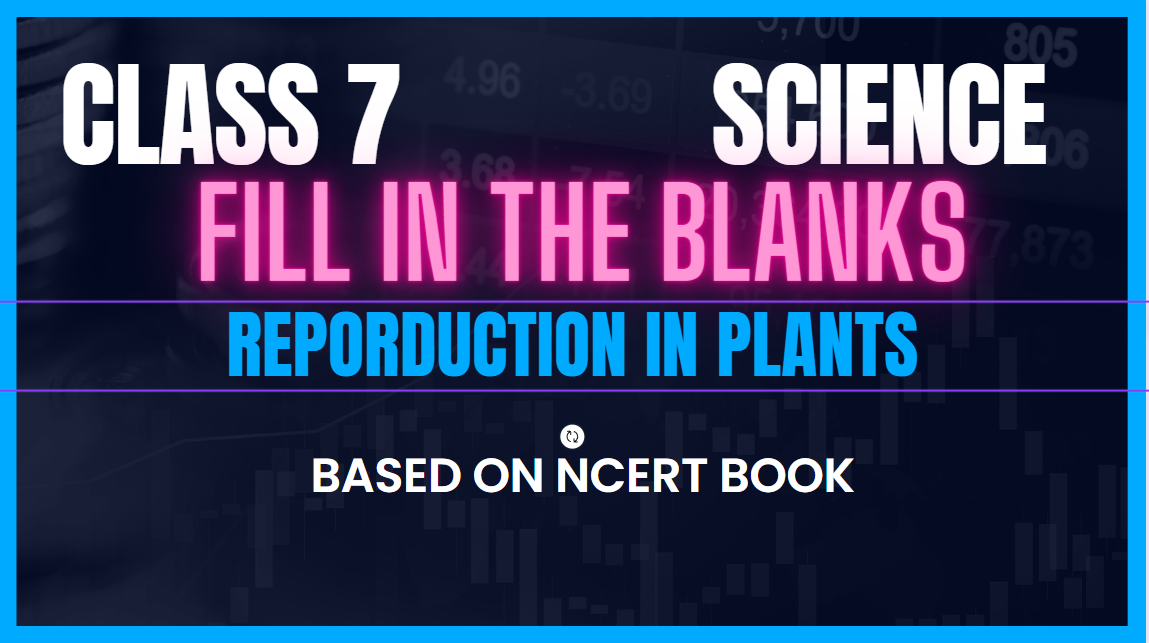1 To produce its kind is a characteristic of ________ living organisms.
Answer: all
Explanation: The characteristic of producing its kind applies to all living organisms.
2 The production of new individuals from their parents is known as ________.
Answer: reproduction
Explanation: The production of new individuals from their parents is called reproduction.
3 Most plants have roots, stems, and leaves, which are called the ________ parts of a plant.
Answer: vegetative
Explanation: Roots, stems, and leaves are referred to as the vegetative parts of a plant.
4 Flowers perform the function of ________ in plants.
Answer: reproduction
Explanation: Flowers serve the purpose of reproduction in plants.
5 Asexual reproduction can give rise to new plants ________ the production of seeds.
Answer: without
Explanation: Asexual reproduction allows for the generation of new plants without the need for seeds.
6 Vegetative propagation is a type of ________ reproduction in plants.
Answer: asexual
Explanation: Vegetative propagation as a form of asexual reproduction.
7 In vegetative propagation, new plants are produced from ________, stems, leaves, and buds.
Answer: roots
Explanation: Roots, along with stems, leaves, and buds, are involved in the process of vegetative propagation.
8 Bryophyllum is a plant that has ________ in the margins of its leaves.
Answer: buds
Explanation: Bryophyllum possesses buds in the margins of its leaves, which can give rise to new plants.
9 Sweet potato and dahlia can give rise to new plants through their ________.
Answer: roots
Explanation: Sweet potato and dahlia are examples of plants that can produce new plants from their roots.
10 Plants produced by vegetative propagation are exact ________ of the parent plant.
Answer: copies
Explanation: Plants obtained through vegetative propagation are identical replicas of the parent plant.
11 Take a _______ of yeast cake or yeast powder from a bakery or a chemist shop.
Answer: pinch
Explanation: Taking a pinch of yeast cake or yeast powder.
12 The small bulb-like projection coming out from the yeast cell is called a _______.
Answer: bud
Explanation: The small bulb-like projection coming out from the yeast cell is called a bud.
13 Algae multiply rapidly by _______.
Answer: fragmentation
Explanation: Algae multiply rapidly by fragmentation.
14 Spores are asexual reproductive bodies covered by a hard _______ coat.
Answer: protective
Explanation: Spores have a hard protective coat to withstand unfavourable conditions.
15 Flowers that contain both stamens and pistil are called _______ flowers.
Answer: bisexual
Explanation: Flowers with both stamens and pistil are called bisexual flowers.
16 The anther of a stamen contains _______ grains.
Answer: pollen
Explanation: The anther of a stamen contains pollen grains.
17 The female gamete or the egg is formed in an _______.
Answer: ovule
Explanation: The female gamete or the egg is formed in an ovule.
18 In sexual reproduction, a male and a female gamete fuse to form a _______.
Answer: zygote
Explanation: A zygote is formed when a male and a female gamete fuse in sexual reproduction.
19 Take a _______ flower and separate its reproductive parts.
Answer: mustard/China rose/petunia
Explanation: Taking a flower of mustard, China rose, or petunia and separating its reproductive parts.
20 Flowers that contain either only pistil or only stamens are called _______ flowers.
Answer: unisexual
Explanation: Flowers with either only pistil or only stamens are called unisexual flowers.
21 Pollen grains can be carried by ________, ________, and ________.
Answer: wind, water, insects
Explanation: Pollen grains can be dispersed by wind, water, and insects.
22 In self-pollination, pollen grains land on the stigma of the ________ flower.
Answer: same
Explanation: Self-pollination occurs when pollen grains land on the stigma of the same flower.
23 The process of fusion of male and female gametes is called ________.
Answer: fertilization
Explanation: Fertilization as the process of fusion of male and female gametes.
24 After fertilization, the ovary grows into a ________.
Answer: fruit
Explanation: After fertilization, the ovary grows into a fruit, as mentioned in the passage.
25 Seed dispersal helps plants prevent ________, ________, and ________.
Answer: overcrowding, competition, invade
Explanation: Seed dispersal helps plants prevent overcrowding, competition for sunlight, water, and minerals, and enables them to invade new habitats.
26 Vegetative propagation involves the production of new plants from ________ parts.
Answer: vegetative
Explanation: Vegetative propagation refers to the production of new plants from vegetative parts like leaves, stems, and roots.
27 The flower is the reproductive part of a ________.
Answer: plant
Explanation: The flower is the reproductive part of a plant.
28 Cross-pollination occurs when pollen grains are transferred to the stigma of ________ flower.
Answer: another
Explanation: Cross-pollination occurs when pollen grains are transferred to the stigma of another flower of the same kind.
29 Fertilization results in the formation of an ________.
Answer: embryo
Explanation: The zygote resulting from fertilization develops into an embryo.
30 Seed dispersal is aided by ________, ________, and ________.
Answer: wind, water, animals
Explanation: Seeds and fruits are dispersed by wind, water, and animals.
